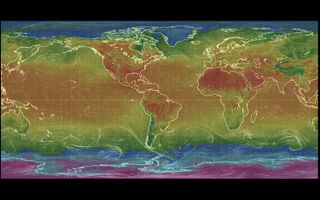Shocking Global Map Shows the Extent of a Global Heat Wave

Earth is boiling under record-high temperatures. Global heat waves have landed thousands of people in the hospital and fueled massive wildfires in places ranging from Greece to the Arctic Circle.
An animation called "earth" shows just how high worldwide temperatures really are. The animation, designed by computer programmer Cameron Beccario, an engineering manager at Indeed Tokyo in Japan, updates every 3 hours with weather data taken from the National Centers for Environmental Prediction's Global Forecast System. [What Is Earth's Average Temperature?]
The system uses supercomputers to create models of the weather from various measurements, like temperature, soil moisture, wind, ocean currents and precipitation, Live Science previously reported.
This week, the mesmerizing globe shines in shades of orange and red, which indicate hot temperatures.
A city outside Tokyo in Japan is facing scorching temperatures of almost 106 degrees Fahrenheit (41.1 degrees Celsius). At least 86 people have died of heatstroke there since May, and 23,000 people have been hospitalized just in the past week, The New York Times reported.
But Japan isn't the only country facing record temperatures. In Sweden, an extreme heat wave caused multiple wildfires to erupt last week — some in the Arctic Circle. Also last week, Greece faced deadly wildfires fueled by extreme temperatures and high winds, killing more than 80 people, The Washington Post reported.
Earlier this month, Ouargla, a city in Algeria, probably logged the highest temperature ever recorded in Africa: 124.3 degrees F (51.3 degrees C), according to the Post. And in June, Oman logged the hottest night in recorded history and the highest low temperature ever to be recorded on Earth: 108.7 degrees F (42.6 degrees C), according to the Post.
Sign up for the Live Science daily newsletter now
Get the world’s most fascinating discoveries delivered straight to your inbox.
Extreme weather — such as the current global heat wave, strong hurricanes and long droughts — is more likely to occur now because of human-induced climate change, according to a previous Live Science report. A preliminary comparison of current temperatures with historical records from seven weather stations in Europe suggests that human-induced climate change made the Europe-wide heat wave more than twice as likely to happen, according to the BBC.
Originally published on Live Science.

Yasemin is a staff writer at Live Science, covering health, neuroscience and biology. Her work has appeared in Scientific American, Science and the San Jose Mercury News. She has a bachelor's degree in biomedical engineering from the University of Connecticut and a graduate certificate in science communication from the University of California, Santa Cruz.